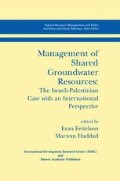Abstract
The importance of demand management as a key component to any joint water management effort between Israelis and Palestinians regarding the use of underground water has been discussed previously (Lonergan and Brooks, 1994).1 The conclusion in these studies was clear: there is a pressing need to focus on demand-side approaches for dealing with water resource problems. Demand management must be a key aspect of any joint groundwater management institution involving Israel and the Palestinians. One essential component of such a policy relates to the establishment of an appropriate price structure for water. Ideally, water users should be charged a rate which is equal to the marginal cost of supplying the water. Although most political jurisdictions have developed water pricing structures, generally they are based on principles of cost recovery rather than demand management. Although there has been considerable debate over this issue, the demand for water is elastic in most cases, and marginal cost pricing will affect the demand for water. However, to be effective any pricing measures must also be accompanied by conservation policies.
“The perception of water as a symbol of ritual purity exempts it to a certain extent from the dirtly rationalities of the market.”
Kenneth Boulding (1964)
Access this chapter
Tax calculation will be finalised at checkout
Purchases are for personal use only
Preview
Unable to display preview. Download preview PDF.
References
Baumol, W. and W. Oates, 1975. The Theory of Environmental Policy. Englewood Cliffs, NJ: Prentice Hall.
Boulding, K., 1964. The economist and the engineer. In: S. Smith and E. Castle (eds.), Economics and Public Policy in Water Resources Development. Ames, Iowa: Iowa State Univ. Press.
Brajer, V., A. Church, R. Cummings and P. Farah, 1989. The strengths and weaknesses of water markets as they affect water scarcity and sovereignty interests in the West. Natural Resources Journal, 29: 489–509.
Chan, A., 1989. To market or not to market: allocation of interstate waters. Natural Resources Journal, 29: 529–547.
Colby, B., Transactions costs and efficiency in western water allocation. American Journal of Agricultural Economics, 72: 1184.
Dudley, N., 1992. Water allocations by markets, common property and capacity sharing: companions or competitors? Natural Resources Journal, 32: 757–778.
Griffin, R., and F. Boadu, 1992. Water marketing in Texas: opportunities for reform. Natural Resources Journal, 32: 265–288.
Hayton, R. and A. Utton, 1989. Transboundary groundwaters: the Bellagio Draft Treaty. Natural Resources Journal, 29: 663–721.
Lonergan, S.C. and D. Brooks, 1994. Watershed: The Role of Freshwater in the Israeli-Palestinian Conflict. Ottawa: IDRC Books.
Moore, M., 1991. The Bureau of Reclamation’s new mandate for irrigation water conservation purposes and policy alternatives. Water Resources Research, 27(2): 116–132.
Okun, A., 1975. Equality and Efficiency: The Big Tradeoff.
Saliba, B., 1987. Do water markets work? Market transfers and trade-offs in the Southwestern States. Water Resources Res., 23: 1113.
Thorson, J., 1989. Water marketing in Big Sky country: an interim assessment. Natural Resources Journal, 29: 479–488.
Tietenberg, T., 1988. Environmental and Natural Resource Economics. Glenview, 111.: Scott, Foresman and Co.
Winpenny, J., 1994. Managing Water as an Economic Resource. London: Routledge.
Wishart, D., 1993. Shock therapy for Middle East water managers. Proceedings of the International Symposium on Water Resources in the Middle East: Policy and Institutional Aspects. Urbana, Illinois, October, 1993, pp. 69–75.
Author information
Authors and Affiliations
Editor information
Editors and Affiliations
Rights and permissions
Copyright information
© 2001 Springer Science+Business Media New York
About this chapter
Cite this chapter
Lonergan, S. (2001). The Use of Economic Instruments for Efficient Water Use. In: Feitelson, E., Haddad, M. (eds) Management of Shared Groundwater Resources. Natural Resource Management and Policy, vol 18. Springer, Dordrecht. https://doi.org/10.1007/978-94-010-0680-4_18
Download citation
DOI: https://doi.org/10.1007/978-94-010-0680-4_18
Publisher Name: Springer, Dordrecht
Print ISBN: 978-94-010-3867-6
Online ISBN: 978-94-010-0680-4
eBook Packages: Springer Book Archive

